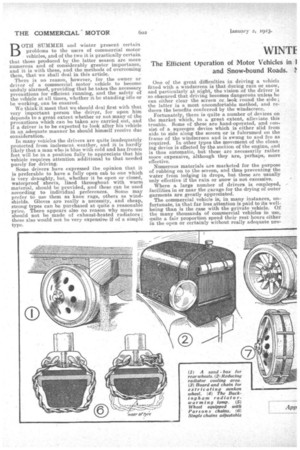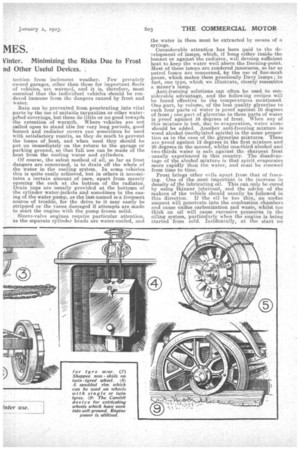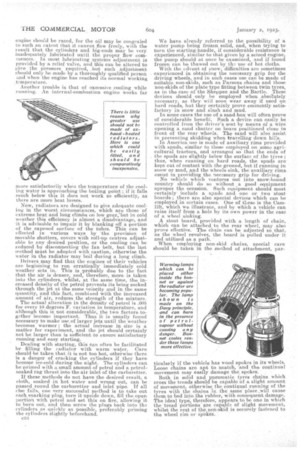WINTI
Page 18

Page 19

Page 20

If you've noticed an error in this article please click here to report it so we can fix it.
MES.
BOTH SUMMER. and winter present certain problems to the users of commercial motor vehicles, and of the two it is practically certain that those produced by the latter season are more numerous and of considerably greater importance, and it is with these, and the methods of overcoming
them, that we shall deal in this article. .
There is no reason, however, for the owner or driver of a commercial motor vehicle to become unduly alarmed, providing that he takes the necessary precautions for efficient running, and the safety of the vehicle at all times, whether it be standing idle or be working, can be ensured.
We think it meet that we should deal first with that very important person the driver, for upon him depends to a great extent whether or not many of the precautions which can be taken are carried out, and if a driver is to be expected to look after his vehicle in an adequate manner he should himself receive due consideration.
In many vehicles the drivers are quite inadequately protected from inclement weather, and it is hardly likely that a man who is blue with cold and has frozen feet will be in a position fully to appreciate that his vehicle requires attention additional to that needed purely for driving.
Some drivers have expressed the opinion that it is preferable to have a fully open cab to one which is very draughty, but, whether it be open or closed, waterproof sheets, lined throughout. with warm material, should be provided, and these can be used according to individual preferences. Some may prefer to use them as knee rugs, others as windshields. Gloves are really a necessity, and cheap, strong types can be purchased at quite a reasonable price. There appears also no reason why more use should not be made of exhaust-heated radiators ; these also would not be very expensive if of a simple type.
One of the great difficulties in driving a vehicle fitted with a windscreen is that during rain or snow, and particularly at night, the vision of the driver is .so obscured that driving becomes dangerous unless he can either clear the screen or. look round the side ; the latter is a most uncomfortable method, and reduces the benefits conferred by the windscreen.
Fortunately, there is quite a number of devices on the market which, to. a great extent, alleviate this trouble. Some of these are hand-operated, and eon, sist of a squeegee deviee which is either slid from side to side along the screen or is fulerumed on the frame of the windscreen and is swung to and fro as required. In other types the movement of the clean. Mg device is effected by the suction of the engine, and is thus automatic, but these are necessarily rather more expensive, although they are, perhaps, more effective.
Numerous materials are marketed for the purpose of rubbing on to the screen, and thus preventing the water from lodging in drops, but these are usually only effective if the rain or snow is not excessive.
Where a large number of drivers is employed, facilities in or near the garage for the drying of outer garments are greatly appreciated.
The cormnercial vehicle is, in many instances, unfortunate, in that far less attention is paid to its wellbeing than is the case with the private vehicle. Of the many thousands of commercial vehicles in use, quite a fair proportion spend their rest hours either in the open or certainly without really adequate pro tection from inclement weather. Few privately owned garages, other than those for important tteets of vehicles, are warmed, and it is, therefore, most essential that the individual vehicles should be rendered immune from the dangers caused by frost and water.
Rain can be, prevented from penetrating into vital parts by the use of suitable tarpaulins or other waterprtof coverings, but these do little or no good towards the retention of warmth. Where vehicles are not called upon to stand idle for very long periods, good bonnet and radiator covers can sometimes be used with satisfactory results, as they do much to prevent the losses of heat, and when used they should be put on immediately on the return to the garage or parking ground, so that full use can be made of the heat from the cooling water and cylinders.
Of course, the safest method of all, so far as frost dangers are concerned, is to drain off the whole of the water, in the cooling system. In some vehicles this is quite easily achieved, but in others it necessitates a certain amount of care, apart from merely opening the cock at the bottom of the radiator. Drain taps are usually provided at the bottoms of the cylinder water-jackets and sometimes in the casing of the water pump, as the last-named is a frequent source of trouble, for the drive to it may easily be stripped or the vanes damaged if attempts are made to start the engine with the pump frozen solid.
Sleeve-valve engines require particular attention, as the separate cylinder heads are water-cooled, and the water in them must be extracted by means of a syringe.
Considerable attention has been Paid to the development of lamps, which, if hung either inside the bonnet or against the radiator, will develop sufficient heat to keep the water well above the freezing-point. Most of these lamps are rendered innocuous, so far as petrol fumes are concerned. by the use of fine-mesh gauze, which makes them practically Davy lamps; in fact, one type, -which we illustrate, closely resembles a miner's lamp. Anti-freezing solutions can often be used to considerable advantage, and the following recipes will be found effective to the temperatures mentioned. One part, by volume, of the best quality glycerine to each four parts of water is proof against 10 degrees of frost; one part of glycerine to three parts of water is proof against 16 degrees of frost. When any of this mixture is lost, due to evaporation, water alone should be added. Another anti-freezing mixture is wood alcohol (methylated spirits) in the same proportion as in the case of the glycerine mixtures. These are proof against 12 degrees in the first mixture and 20 degrees in the second, whilst one-third alcohol and •. two-thirds Water is safe against the sharpest frost usually experienced in this country. The disadvantage of the alcohol mixture is that spirit evaporates more rapidly than the water, and must be renewed from time to time.
Frost brings other evils apart from that of freezing. One of the most important is the increase in density of the lubricating oil. This can only becured by using thinner lubricant, and the advice of the makers of the vehicle should usually be followed in this direction. If the oil be too thin, an undue amount will penetrate into the combustion chambers and cause undue carbonization and waste, whilst too thick an oil will cause excessive pressures in the oiling system, particularly when the engine is being started from cold. Incidentally, at the start no engine should be raced, for the oil may be congealed to such an extent that it cannot liow freely, with the result that the cylinders and big-ends may be very inadequately lubricated until the proper flow commences. In most lubricating systems adjustment. is provided by a relief valve, and this can be altered to give the pressure required, •;hut such adjustment should only he made by a thoroughly qualified person and when the engine has reached its normal working ,temperature.
Another trouble is that of excessive _cooling while running. .An internal-combustion engine Works far more satisfactorily when tile temperatureof the cooling water is approaching the boiling point ; if it falls much below this it does not, work so efficiently, as there are more heat losses.
Now, radiators are designed to give adequate cooling in the worst circumstances, which are those of extreme heat and long climbs on low gear,'-but in cold weather this efficiency is almost a disadvantage, and it is advisable to impair it by blanking off a portion of the exposed surface of the tubes. This can be effected in various ways by the provision of movable shutters, covers with roll-up centres adjustable to any desired position, or the cooling can be reduced by disconnecting the fan belt, but the last method must be adopted with caution, otherwise the water in the radiator may boil during a long climb.
Drivers may find that the engines of their vehicles are beginning to run erratically immediately cold weather sets in.This is probably due to the fact that the air is denser, and, therefore, more is taken into the cylinders, whilst, at the same time, the increased density of the petrol prevents its being sucked through the jet at the same velocity and in the same quantity, and this fact, combined with the increased amount of air, reduces the strength of the mixture.
The actual alteration in the density of petrol is .005 for every 10 degrees F. variation in temperature, and although this is not considerable, the two factors. together become important. Thus it is usually found necessary to make useof larger jets until the weather becomes warmer ; the actual increase in size is a matter for experiment, and the jet should certainly not be larger than is sitferent to ensure 'satisfactory running and easy starting.
Dealing with starting, this can often be facilitated by filling the radiator with warm water. Care should be taken that it is not too hot, otherwise there is a danger of cracking the cylinders if they have become ice-cold during the night. The cylinders can be orimed with a small amount of petrol and a petrolsoaked rag thrust into the air inlet of the carburetter.
If these methods do not have the desired result, a cloth, soaked in hot water and wrung out, can be passed round the carburetter and inlet pipe. If all else fails, one very successful method is to take out each sparking plug, turn it upside down, fill the open portion with petrol and set this on fire, allowing it to burn out, and then screw the plugs back into the cylinders as quickly as possible, preferably priming the cylinders slightly beforehand. 044.
We have already referred to the possibility of a water pump being frozen solid, and, when trying to turn the starting-handle, if considerable resistance is experienced, similar to that given by a seized engine, the pump should at once be examined, and if found frozen can be thawed out by the USE of hot cloths.
With the advent of snow, difficulties are sometimes experienced in obtaining the necessary grip for the driving wheels, and in such cases use can be made of suitable non-skids, such as Parsons chains and those non-skids of the plate type fitting between twin tyres, as in the case of the Sheppeo and the Bartle. These devices should only be employed when absolutely necessary, as they will soon wear away if used on hard roads, but they certainly prove eminently satisfactory in snow and slush and mud.
In some cases the use of a sand-box will often prove of considerable benefit. Such a device can easily be controlled from the driver's seat by means -of a wire opening a sand shutter on boxes positioned close in front of the rear wheels. The sand will also assist in preventing skidding when travelling down hills.
In America use is made of auxiliary rims provided with spuds, similar to those employed on some agricultural tractors,, and arranged so that the ends of the spuds are slightly below the surface of ;the tyres ; thus, when running on hard roads, the spuds are kept out of contact with the ground, but if running in snow or mud, and the wheels sink, the. auxiliary rims assist in providing the necessary grip for driving. No -vehicle which ventures out into snow-houndcountry should do so without a good equipment apropos the occasion. Such equipment should most certainly include a spade and one or two stout boards ; there are also special devices • which can be employed in certain cases. One of these is the. Camlift, which we illustrate, and by which a vehicle can raise itself from a hole by its own power in the case of a wheel sinking. A stout board, provided with a length of chain, which can be attached to the rear wheel, may also prove effective. The chain can be adjusted so that, as the wheel revolves, the board is pulled under it and utilized as a path.
When employing non-skid chains, special care should be taken in the method of attachment., par.
ticuIarly if the vehicle' has wood spokes in its wheels. Loose chains are apt to snatch, and the continual movement may easily damage the spokes.
Both in solid and pneumatic tyres chains which cross the treads should be capable of a slight amount of movement, otherwise the continual running of the tyres with the chains in, the. sanie 'place „will cause them to. tied into the rubber, with consequent damage. The ideal type, therefore, appears to be one in which the tread portions are eapsdale of slight movement, whilst the rest of thenaon:skid is securely fastened to the wheel rim or spokes.






























